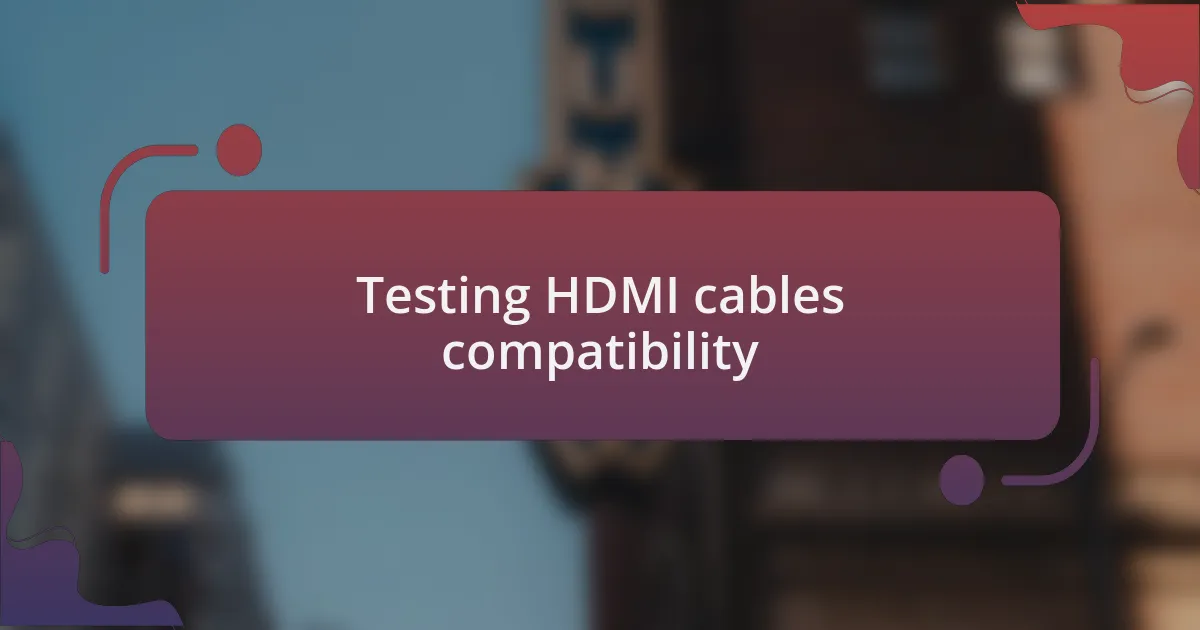Key takeaways:
- HDMI cables’ performance is influenced by specifications such as version, construction quality, and length, which can impact video and audio clarity.
- Choosing the right HDMI cable is crucial for utilizing advanced features like 4K, HDR, and Dolby Atmos in home theater setups.
- Brand reputation and cable shielding are important for reducing interference and ensuring reliable performance during playback.
- Experiences with different cables highlight the significant differences in quality, affecting overall enjoyment and compatibility with devices.

Understanding HDMI cables performance
When assessing HDMI cable performance, it’s crucial to understand how different specifications influence the quality of your video and audio. I recall upgrading my home theater setup and feeling the excitement of streaming 4K content for the first time. It was there that I truly appreciated the difference a quality HDMI cable can make; I could see the vibrant colors pop and hear the audio nuances I had previously missed.
Cable length plays a significant role as well. Have you ever noticed that a longer HDMI cable might result in a slight degradation of quality? I once tried using a 50-foot cable for my system, only to see some pixelation on my screen. It was a frustrating experience that underscored the importance of choosing the right length for your setup.
Additionally, the HDMI version matters greatly—whether it’s 1.4, 2.0, or the latest 2.1. I remember being puzzled about the different versions at first, wondering if it really made a difference. After a bit of research, it became clear: the features like dynamic HDR and higher refresh rates could enhance my viewing experience significantly. Choosing the right cable is more than just a purchase; it’s a commitment to enjoying the best possible viewing experience.

Importance of HDMI in Blu-ray
The HDMI connection is pivotal for Blu-ray players because it delivers high-definition video and audio through a single cable. I remember my first time hooking up my Blu-ray player; I was utterly amazed by how seamless the connection was. The clarity of the picture was stunning, and I realized that the magic of home cinema really hinges on this simple yet powerful technology.
But let’s not underestimate the role of HDMI in supporting advanced features. When I discovered that my Blu-ray player could play back movies in 3D and Dolby Atmos sound, I was thrilled. It made me think—how could I fully enjoy those immersive experiences without a top-notch HDMI cable? It quickly became apparent that choosing the right cable wasn’t just about specifications; it was about ensuring my whole setup could showcase the cinematic experiences I craved.
Beyond just technical capabilities, HDMI connectivity enhances convenience too. I once had a guest over to watch a movie, and I was pleasantly surprised at how effortlessly everything linked together. With just one HDMI cable, I could control my sound system, projector, and Blu-ray player with ease. It hit me then that HDMI isn’t just a connector; it’s the backbone of a simplified, integrated entertainment experience.

Key factors affecting HDMI quality
When it comes to HDMI quality, one of the most critical factors is the cable’s construction. High-quality materials can make a significant difference. I remember upgrading to a premium HDMI cable, and the difference in picture and sound clarity was instantly noticeable. It’s fascinating how the choice of copper versus lesser materials can affect signal transmission. Have you ever wondered why some cables cost significantly more? It’s often about the materials and technology used in their design.
Another key factor is the cable length. I used to think longer cables were better until I learned how lengths beyond a certain point can introduce signal degradation. When I had to run a long cable to my projector, I opted for an active HDMI cable, and it worked wonders. It made me appreciate that there’s a sweet spot in cable length where performance meets practicality.
Finally, compatibility with the HDMI specifications is paramount. Different versions of HDMI, like 2.0 versus 2.1, bring unique features to the table. When I first set up my ultra-high-definition Blu-ray player, I realized that I needed a cable that could handle not just 4K but also higher frame rates. It’s eye-opening how a minor oversight in cable selection can mean the difference between a stunning viewing experience and a frustrating one.

Evaluating HDMI cables for Blu-ray
When evaluating HDMI cables for Blu-ray, I’ve found that the brand can influence performance significantly. I once purchased a seemingly mainstream cable, only to experience frequent audio dropouts during movie playback. It was frustrating; I had chosen it based on price alone, not realizing that reputable brands invest more in quality control and technology. Have you ever felt that pang of disappointment when your setup doesn’t deliver the experience you anticipated?
Another aspect worth considering is the cable’s shielding. I’ve had my share of tangled cords behind the entertainment center and noticed that well-shielded cables seem to have less interference. When I switched to a shielded HDMI cable for my Blu-ray player, the image clarity improved remarkably, especially during action-packed scenes. This little change made me curious—how often do we overlook the basics that could enhance our viewing pleasure?
Lastly, I think it’s essential to look for future-proofing features, especially if you’re investing in a high-end Blu-ray player. When I upgraded to a model that supports HDR and 4K, I initially used my old HDMI cable. The visual discrepancies were disheartening until I opted for a high-speed HDMI cable built for these features. It was a game-changer; the colors popped, and detail emerged that I didn’t even know was missing. Isn’t it amazing how the right cable can transform your viewing experience?

Testing HDMI cables compatibility
Testing the compatibility of HDMI cables can feel a bit like trial and error. I recall when I first connected my Blu-ray player to my home theater system—everything seemed fine at first. However, I quickly discovered the incompatibility when I noticed that I wasn’t getting the expected audio quality. It led me to research more about specifications and how certain cables may not support all features, like Dolby Atmos.
In my quest for the perfect connection, I learned that not all HDMI cables are created equal. During one test, I used a cable rated for standard video, and to my dismay, I couldn’t achieve the desired 4K resolution. The moment I switched to a higher-rated cable, I felt a surge of excitement as vibrant colors filled my screen. Have you ever experienced that thrill when upgrading your components and realizing the profound difference it can make?
Moreover, proper testing involves checking the cable against various devices as compatibility can vary widely. I remember trying out my HDMI cable across multiple setups—my laptop, a game console, and my Blu-ray player. Each experience highlighted that some cables excelled with certain formats or resolutions, leaving me both enlightened and frustrated at times. Isn’t it fascinating how the nuances in cable performance can influence the entire viewing experience?

Personal experiences with HDMI cables
When I first started exploring HDMI cables, I had no idea how much they could impact my viewing experience. I remember the day I opted for a budget cable just to save a few bucks and was greeted by a washed-out picture on my screen. It was a frustrating reminder that what you can’t see can indeed affect everything—like the invisible quality that separates a mediocre cable from a high-performance one.
In another instance, I experimented with a premium HDMI cable during a movie night with friends. The moment I connected it, the difference in picture clarity and sound was almost immediate. I can still recall the collective gasp from everyone as colors popped and dialogue became crystal clear. Have you ever had a moment when you realized just how crucial the right equipment can be for those shared experiences?
Lastly, I learned the hard way that even the best HDMI cables can falter without the right support. I had a stunning movie lineup planned, only to face connectivity issues when using an older receiver. After switching to a newer model that supported 4K, the upgrade felt like unlocking a new level in gaming. That experience taught me that HDMI cables are just one part of the equation; it’s about how every piece of equipment interacts to create that seamless experience.

Recommendations for best HDMI cables
When considering the best HDMI cables, I’ve found that certified High-Speed cables make a world of difference. Once, I invested in an ultra-high-speed cable, and the sharpness of the 4K visuals was something that I had only dreamed of achieving. Have you ever wondered if the clarity really matters?
I also recommend looking for cables with gold-plated connectors for better conductivity. I recall a time when I swapped out a standard HDMI cable for one with this feature. The improvement in sound quality during a particularly intense action scene was remarkable—it’s almost as if the audio was enveloping the room. It’s those details that elevate your experience.
Lastly, don’t overlook the benefits of length when choosing your HDMI cable. I’ve often encountered situations where a longer cable was necessary for my setup, but I learned that not all long cables maintain signal quality. After a few trials, I settled on a 10-foot cable that perfectly balanced length with performance. Have you ever faced a similar challenge? Finding that sweet spot can truly enhance your overall viewing or gaming experience.